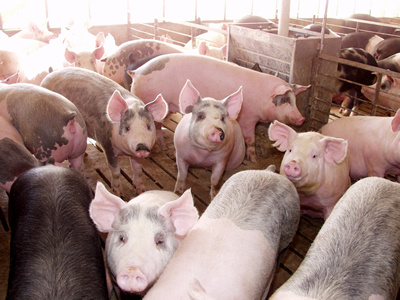Bird flu, which killed more than 82 million birds in U.S. domestic flocks in the past two years,...
U.S. Detects H5N1 Bird Flu in a Pig for the First Time, Plus More Human and Cattle Infections

The USDA said there is no risk to the nation’s pork supply from the Oregon case and that the risk to the public from bird flu remains low.
H5N1 bird flu was confirmed in a pig on a backyard farm in Oregon, the first detection of the virus in swine in the country.
Pigs represent a particular concern for the spread of bird flu because they can become co-infected with bird and human viruses, which could swap genes to form a new, more dangerous virus that can more easily infect humans.
Pigs were the source of the H1N1 flu pandemic in 2009-2010, and have been implicated as the source of others, said Richard Webby, a St. Jude Children’s Research Hospital virologist who studies flu in animals and birds for the World Health Organization.
“The finding of the virus in a small farm makes the pig infection less of a concern than if it had been detected in a commercial pig farm,” Webby said. “I think it probably doesn’t increase the risk much, but surely, if this virus starts transmitting in pigs, that absolutely increases the risk,” he said.
The Oregon farm has been quarantined, and other animals there, including sheep and goats, are under surveillance, USDA said.
Also, this year, 39 people have tested positive for bird flu as the virus has spread to nearly 400 dairy herds. Bird flu most recently has infected three more people from Washington state after they were exposed to poultry that tested positive for the virus. All but one of the people were farm workers who had known contact with infected animals.
In addition, the first round of mandatory milk testing in northern Utah identified bird flu infections in eight dairy herds, said the Utah Department of Agriculture and Food. Utah is the 15th state to report the avian flu virus in dairy cattle since the disease was first identified in herds in Texas in March. Quarantines were imposed on the infected herds, and farmers were asked to implement biosecurity measures to keep the virus from spreading.
Since 2022, the virus has wiped out more than 100 million poultry birds in the nation’s worst-ever bird flu outbreak.
EDITOR’S TAKE:
Just when we think this virus is not spreading, boom, another surprise. Now it has spread to poultry, cattle, pigs and humans. The experts suggest it is under control and not a serious threat to humans, but this latest development suggests that it could now be more of a threat if it is found in commercial hog operations. We certainly hope it is confined to the one incident in Oregon. The variable that makes it difficult to control is being spread by wild, migratory birds. Animals housed outside are most susceptible. Also, if not careful, human traffic in barns and confined units can carry the virus. Biosecurity measures are critical for controlling the disease. We will continue to keep you informed about this issue since it could impact farm/ranch operations in your area.








